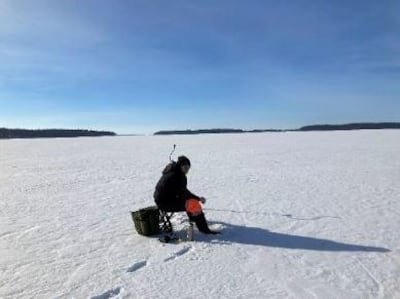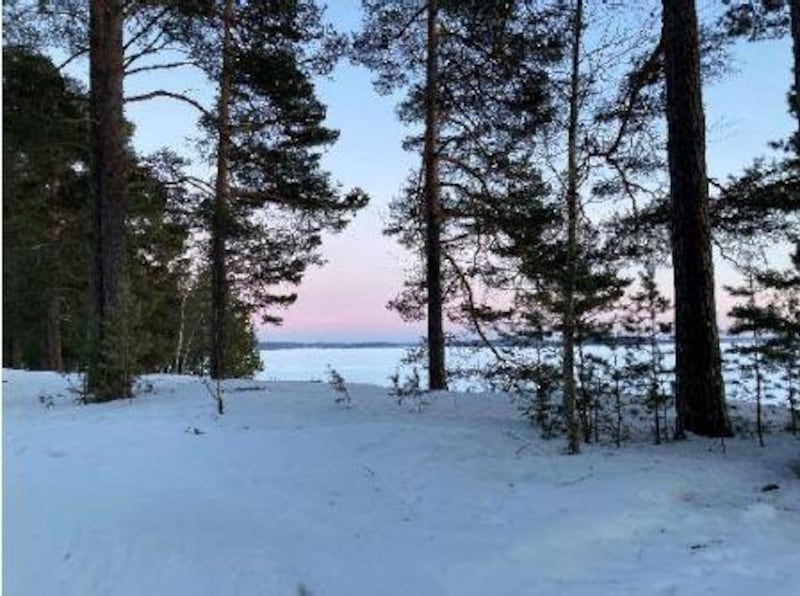It's early March in South Karelia, a rural region in eastern Finland, just five miles from the Russian border. I live with my Finnish wife in Sheffield, and we come here every year to ski cross-country, in the forests and across the frozen lakes. The sky is a cloudless blue over a landscape of dazzling white. The silence is punctuated by the tweets of the first birds of spring, and the rat-tat-tat of gunfire from the Finnish border guards on training manoeuvres.
This, to me, has always been a comforting sound, now more than ever. It is just a week since the invasion of Ukraine and it seems unfair that here is a beautiful peaceful scene, while on another Russian border, innocent people are victims of a brutal horror. Then I realise it happened here too, in this very place.

Here too, a small independent country was invaded. It was November 1939. Then, as now, young Russian soldiers left their mothers with little idea or motivation for the mission. Then, as now, they met an army defending their country, their families, their lives. The world looked on as Finland, outnumbered and without tanks or heavy armour, withstood the might of the Red Army for three months in what became known as the Winter War.
The Finnish soldiers wore white and moved through the forests on skis, a terrain they knew well, with a rifle on their back and a Molotov cocktail in their belt. The Russian infantry were not camouflaged and were poorly dressed against the cold. Their tanks were restricted to the few narrow roads among the forests, in single file.
The Finns allowed them to advance deep into the country, then hit the supply lines behind. Molotov cocktails were aimed at the ventilation slots in the stranded tanks, to deadly effect. Finnish snipers picked off the officers when they camped, aware of the hierarchic rigidity of Russian command. This left the squadrons leaderless and lost. Night temperatures in winter here can be minus-20 degrees. Even by Finnish standards, it was a very cold winter. The Russians were ill-prepared, and many froze in their tanks.
The White Death
Close to here, at Ruokolahti we once visited the grave of Simo Häyhä, a farm boy who grew up hunting, became a sharpshooter and by 1939 a sniper in the Finnish army. He eschewed the army issue rifle for his own gun, and ditched the telescopic sight, because the sun can catch the glass and reveal your location. Relying only on the iron sights of his rifle, he would dig in under the snow with sugar, water and bread, and wait for his prey.
He was responsible for killing more than 500 Russians and became known as the White Death. His career ended in 1940, when he was finally hit by a Russian sniper, and though critically injured, he lived to 96 years.
Nobody came to Finland's aid from the Allies. Eventually, after bombing Helsinki and by sheer weight of numbers, Russia prevailed and took 11 per cent of Finnish territory, mostly here in Karelia. This resulted in a massive exodus of refugees to the west of the country. But Finland was not taken. It has remained an independent country to this day.
Every village here bears the legacy of that war. In the peaceful country churchyards, in the shadows of the trees, rows of granite headstones are set in the grass. Each simply bears a name and a date, small monuments to the soldiers who died here.
I grew up in Dublin, moving to London in the late seventies. There I met my Finnish wife and a few years later we got married in Helsinki, in one of the two Catholic churches, across the road from the Russian embassy.
This was the last decade of the Soviet era. We went by train to Leningrad, now St Petersburg, for our honeymoon and stayed in the faded grandeur of the Hotel Europesca.
Finland’s progress
I have been coming to Finland regularly for more than 40 years now. Through those decades the country has developed from the post-war era of Soviet influence, to become a modern European economy.
Perhaps given the pressures of hostile winters and the huge war reparations imposed by Russia, Finland developed from an agricultural economy, gaining a reputation for engineering and technology. During the Cold War it benefited from its relationship and proximity to Russia, importing raw materials and selling back high value goods.
After the dissolution of the Soviet Union, Finland joined the EU and looked more westward. So did a developing middle class in Russia. Here in the regional town Imatra, we are nearer to St Petersburg than Helsinki. The area prospered as Russians moved to buy land here, build summer cottages and take holidays by the lakes.

Over the decades they came here to shop, to work in the stores and factories, many met Finnish partners, and are now part of the local population. Finland by this time had become a vibrant economy, the home of Nokia, and renowned for its Nordic modern design.
But suddenly the old Cold War fears have returned. There is a 1,340km land border with Russia. In the space of a few weeks, Finland has gone from a population comfortable with the country’s neutral status, to one where 73 per cent now want to join Nato. This compared with 28 per cent in January.
It is likely to join without delay, with politicians eager and Nato apparently receptive, even while Moscow makes dark threats about the consequences of Finnish membership.
The feeling is likewise in neighbouring Sweden, a country that also has a long tradition of neutrality. Within two weeks of the invasion, the prime ministers of both countries met in urgent talks about future defence strategy.
Both the Finnish president, who has met Biden and Putin in recent weeks, and the young prime minister Sanna Marin, have appealed to the public to be sympathetic to the Russian population living here. Both are well respected, their ratings higher than ever. Marin has already proved herself with her handling of Covid and achieving one of the lowest death rates in Europe.
Memory of invasion
This is a region with a folk memory of invasion. My father-in-law fought here on artillery, my mother-in-law left Karelia before the war, her family home is now in Russian-occupied territory.
Elsa, who cuts my hair, says she cannot listen to the news, since the attack on Ukraine. Her grandfather was wounded in the war and her grandmother became a refugee.
Our friends, a local couple, come over for dinner one night. He recalls when a Russian delegation came to work in their factory, and how they could not understand the Finnish way of co-operation and teamwork. They were conditioned to take instructions directly from a line manager. His partner talks of a return of an old feeling here, the urge to have a suitcase packed and ready to leave at short notice.
Saturday is karaoke night in the village bar. Before Covid, there was late-night revelry here, then the pandemic caused a two-year hiatus, only recently ended. But the mood is no longer there. The music is loud and the lights are bright, but the room is empty.
In the dimly lit bar area, small groups of young people sit at tables and a few older men drink in a corner. The barmaid stares out over the heads of the customers, as the music plays next door. It is a melancholy scene, straight from an Aki Kaurismäki film.
I talk to a few of the young locals. I ask about Ukraine, and how it feels to be living here. One says how he loves Russian culture and the people, that it’s just the government is the problem.
I said how I admired the spirit of the Finns in the Winter War, and the heroic stand they made. He shrugged. “It was a very cold winter”, he says. “The Russians were not prepared.”
This is very Finnish. Stoical, down to earth, a people used to surviving in adversity. There is even a Finnish word for it: sisu. We would still be singing songs about it, were this an Irish story.
I pointed out how conscription was still in practice here, there are almost one million men with military training who can be called up to defend their border. “No”, another says. “They will come with missiles if they come, no longer is it men and tanks fighting. There will be so many missiles we will have no chance.”
This is not the spirit of 1939 and not the spirit we see in Ukraine these days. I would not doubt the Finnish spirit, nor their military capability, if it comes to the test. The mood here now is fear and anger, defiance would come in time of need. As it has in Ukraine.
Happiest nation
This week, Finland has been voted by the UN the world’s happiest nation. This is for the fifth year in a row. I ask my wife what in this case “happiest” really means, given the Finns are not known for extroversion or outward displays of jollity.
It is being able to get a hospital appointment next week, she says. It is confidence in the standard of healthcare and education, free schooling, free school meals and books for all, free university education. It is a lack of corruption in public office, trust in government and in public bodies including the police. It is state-subsidised childcare for all, generous maternity and paternity leave.
In a cold climate survival depends on teamwork, resulting in a collectivist culture and governance. The result is an acceptance that the rich will pay higher taxes, but nobody starves or sleeps on the streets.
It is the end of March and the snow is melting. We ski on the lake for the last time. Out in the middle, we come upon a lone man, ice-fishing. He says he is fishing for perch, but they are small. I have seen these perch. They come close in little shoals as we swim here in June, and the sandy beach is populated with young families, and temperatures over 25 degrees, just three months from now.
But as the snow melts and spring opens the lake, the country is heading for a return to the old fears of the Cold War. There are no metaphors here.
On the way home we look at the animal tracks in the snow. There may be hare, fox, elk or lynx. The wolves do not come this close to habitation but can be heard further east, in the wilderness around the border. “The bears will be waking soon,” my wife says. There are no metaphors here. We hope.










